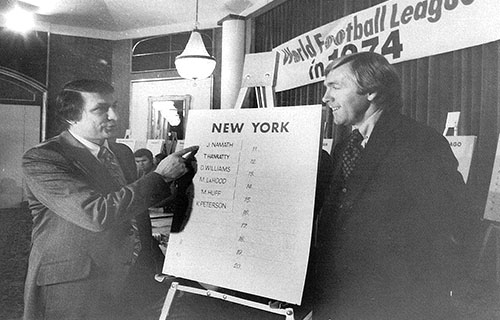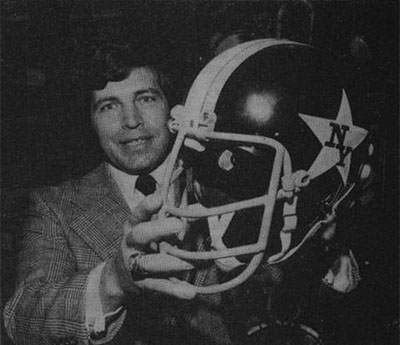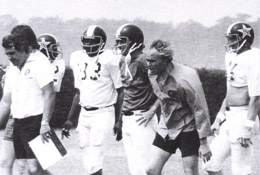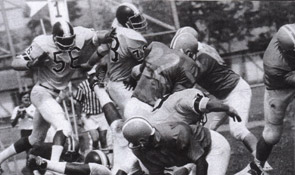


October 2, 1973 - The World Football League, the creation of Gary L. Davidson who formerly was president of the American Basketball Association (ABA) and at the time served as commissioner/president of the World Hockey Association (WHA) during both leagues' early stages, introduces the WFL as the next entity in an already crowded field of sports leagues. Davidson takes center stage in the Chicago press conference to introduce the first six cities, what he called "the founding fathers" of his invention: Boston, Chicago, New York, Los Angeles, Honolulu, and Toronto of the proposed 12-team pro football league. Other cities considered for the neophyte WFL include Birmingham, Miami, Philadelphia, London, England and Tokyo, Japan.
November 1973 - Howard Baldwin, a young hockey prospect, begins to assemble his WFL Boston Bulldogs franchise. Baldwin, the co-owner of the WHA New England Whalers with Bob Schmertz - who incidentally is holding the unnamed New York franchise, brings in Dusty Rhodes to the Boston project. Rhodes, who possesses an encyclopedic knowledge of football and hockey players and once worked in the front office of the AFL-NFL Boston-New England Patriots, will be one of the first pioneering women to hold an executive position in pro football, with the title as assistant General Manager.
January 14-15, 1974 - The WFL holds its first official meeting, in Los Angeles, Calif., and representatives of the 12 franchises along with prospective owners, investors, coaches, players, reporters, and football fanatics attend. The Boston Bulldogs go through an 11-hour nickname procedure, reducing Bulldogs to Bulls. The New York franchise still has no moniker, much less a coach, players, or a stadium to play in.
January 21, 1974 - Boston Bulls president-owner Howard Baldwin announces the hiring of Vito "Babe" Parilli as the WFL team's new head coach. Parilli, at the time the quarterbacks coach of the Pittsburgh Steelers and a veteran quarterback who played for several NFL and AFL teams, is thrilled to get his first opportunity to be a head coach in a new pro football league.

Babe Parilli and WFL Commissioner, Gary L. Davidson at the Boston Bulls press conference.
January 22, 1974 - The World Football League held its first collegiate draft at the Essex House in New York City. The Boston Bulls with their first pick select Boston College quarterback, Gary Marangi.

The Bulls brain trust, Dusty Rhodes, Coach Parilli, and Howard Baldwin at the WFL College Draft.
February 5, 1974 - Boston Bulls announced the signing of former New York Jets wide receiver, George Sauer. Sauer retired in 1970, and was a former teammate of Bulls head coach Babe Parilli, when they both played for the Jets Super Bowl III team.
February 18, 1974 - A fruitless search of investors in the Boston area combined in that city's unwillingness in giving the Bulls a lease to play in any of its stadiums, Howard Baldwin's only option was to team up with his WHA partner, Bob Schmertz's New York franchise. WFL President Gary Davidson gives the green light to allow the two teams to merge as one. The Boston-New York marriage is a tricky one; the Bulls move its entire operation to New York while trading Baldwin's draft lists to Gotham and getting Schmertz's New York picks in return. The Boston draft list and the original New York charter eventually ends up in Portland, Oregon in which the WFL's 12th franchise transmogrifies into the Portland Storm.
March 4, 1974 - The ersatz "New York Bulls" are given a new lease on life as the entry in the fledgling World Football League will be now known as the New York Stars, and will wear the colors of black and yellow of old Broadway. Robert Keating, former General Manager of the Atlantic Coast Football League's New England Colonials, was named as the Stars Vice President and General Manager.
March 18, 1974 - The World Football League holds a Pro Draft. Players from the National Football League and Canadian Football League are selected by each WFL team in a 40 round draft. The draft was held at the Marriott Essex House in New York City. Prior to the pro draft the Stars signed New York Jets defensive tackle John Elliott. The New York Stars first selection in the pro player draft was New York Jets QB Joe Namath.

John Elliott proudly displays his WFL contract he signed with New York Stars owner, Bob Schmertz prior to the WFL Pro Draft.

Head coach Babe Parilli displays the New York Stars Pro Draft selections to WFL Commissioner, Gary L. Davidson.
March 31, 1974 - The Toronto Northmen push the WFL to the forefront with the $3.5 million package signing of Miami Dolphins, running backs Larry Csonka, Jim Kiick, and wide receiver Paul Warfield. The shocking signing of the Miami trio puts the NFL on notice. The New York Stars attempted to make a blockbuster signing of sorts, offering million-dollar contracts to quarterbacks: Terry Bradshaw of the Pittsburgh Steelers and Marty Domres of the Baltimore Colts, but neither player expresses interest in jumping to the WFL, however.
Towards the end of March the New York Stars negotiated a lease with LA Salle Military Academy on Long Island. It served as the Stars training camp for 1974.
April 1974 - Stars' officials announce that they have signed a two-year lease to play their home games at the former Triborough Stadium - renamed Downing Stadium on Randalls Island. Upon signing the lease, team general manager Bob Keating told Bob Schmertz that "with all the renovations, we just lost $600,000." "That's life, I guess," Schmertz replied dryly. By the first days of summer of 1974, approximately 6,000 to 7,000 season tickets are sold.
April 25, 1974 - New York Stars sign Gerry Philbin, another former New York Jets Super Bowl III veteran. Former Green Bay Packers and Pittsburgh Steelers defensive end, Lloyd Voss also signs for the 1974 season. Defensive End, Carter Campbell is signed to a future WFL contract.

Gerry Philbin displays his New York Stars helmet after signing to play in the WFL for the 1974 season.
May 2, 1974 - The Stars sign former New York Giants wide receiver Homer Jones.
June 3, 1974 - Training camp opens at the LaSalle Military Academy, in Oakdale, New York. 104 players arrive the first day and by the final days, Babe Parilli's staff cobbles together a 33-man roster with an additional five players on the practice-taxi squad. Among the notable cuts include, former Olympian John Carlos - infamous for raising a black-fisted glove during the 1968 games; ex-Jets Randy Beverly and Sam Walton. Pleasant surprises in camp include rookies, cornerback Jeff Woodcock and quarterback Gary Danielson, who both make the squad. In that month, the Stars and Philadelphia Bell play each other in two scrimmages; New York wins the first one, 10-7, but Philadelphia squeaks by in the rematch, 24-22.

Head Coach Vito "Babe" Parilli opens camp.

Coach Dick Conners and Coach George Boutselis work with the defense.

New York Stars vs. Philadelphia Bell scrimmage at Central Islip High School on June 22, 1974.
July 10-11, 1974 - Opening gambit as the WFL kicks off the 1974 campaign with surprisingly large crowds as an estimate 248,000 attend the five Wednesday evening contests, with a high in Philadelphia (55,534), and a low in Orlando (18,625). The following night, in front of 59,112 in Jacksonville's Gator Bowl and a TVS televised audience, the Jacksonville Sharks defeat the New York Stars, 14-7. New York suffered in the punting game; the Sharks' Alvin Wyatt returned the ball 87 yards for a touchdown on one punt, and former Oakland Raiders enforcer Ike Lassiter blocking a Robby Reynolds punt in the fourth quarter that led to the winning touchdown for the Sharks. An earlier gamble by Coach Parilli by going for the touchdown on fourth down rather than a chip-shot field goal misfires when Jacksonville's goal-line stance keeps the Stars out of the end zone. George Sauer was the Stars star, catching seven passes in the game. Among the attendees at the game: WFL Commissioner Gary Davidson and TVS Network guest George Plimpton.
July 17, 1974 - The seemingly improbable is accomplished after several weeks of cleaning, removing years of caked dust and debris as the New York Stars home opener is not only a success, but many fans attending give favorable reviews of Gotham's newest pro grid team, in spite of the heavy traffic going in and out of Randalls Island and the weak candlepower from the old Ebbets Field light towers. They fall short of a sellout as 17,943 try to get comfortable in the 22,000-seat edifice, which helps a bit by using Stars' seat cushions. Immediately, the hosts bombard the visiting Birmingham Americans for the first half for a comfortable 29-3 lead. But in the second half, the Stars, as well as the visibility on the field, fade to black. Journeyman quarterback George Mira conducts an amazing comeback; firing three touchdown passes and running another one all his lonesome. The winning TD catch is miraculously caught by a surprised Dennis Homan, Birmingham's veteran wide receiver. The former Dallas Cowboys No. 1 pick in 1968 admits he never got sight of the ball until he noticed it just before it hit him in the bread basket. New York kicker Pete Rajecki misses on the field goal attempt to tie the game late in the fourth quarter, and in the process injures his kicking foot. Thus, the game ends as Alabama falls on the Stars, 32-29.
July 25, 1974 - The loss of Pete Rajecki sets up this week's newest hero, kicker Moses Lajterman who was working as a Dannon Yogurt salesman around the time the New York Stars lost its second game in a row. Lajterman had been cut by the Stars during training camp, and failed a tryout with the Philadelphia Bell, now this week's opponent. The Thursday night TVS Game of the Week draws an incredulous 64,719 fans in old J.F.K. Stadium - as it turns out the following August, most of them paid little to nothing to attend. At the time Gary Davidson was in attendance, he couldn't help but blurt out "this is incredible" that his former franchise had come this far, this popular. At halftime, the Philly and Gotham fans got so unruly that Mayor Rizzo's aggressive police on horseback collected the riotous herd right back to their wooden planks that acted as seating arrangements. Lajterman's 40-yard field goal would seal the deal for Coach Babe Parilli's first win as a pro football head coach, but it wasn't a cakewalk as Vito feared losing a third game as The Bell set up not one, but two winning field goal moments. But then the late in the fourth quarter cliché of the two-minute warning turned into an episode of the Twilight Zone. The first attempt, a 36-yard try by Jack Simczak with 2:18 left, sailed wide right. Simczak later admitted sheepishly that he had lost, or somebody stole his regular kicking shoe, and had to borrow another player's shoe. George Chatlos came in with one second to play, but he too muffed it, and New York escaped the howls of Philadelphians with an ugly 17-15 victory. So vicious was the fan reaction to the Bell losing the game on a pair of easy field goal tries that the Stars' cheerleaders were given a police escort to get out of the coliseum alive.
To Be Continued...
NOTE: The Hornets History page was written exclusively for the Charlotte Hornets Football Network by WFL Historian, Chuck Gardner with assistance from Richie Franklin, Jim Cusano and Mark Speck. The Hornets History cartoon drawing was created by Gene Sanny. Photos provided by Richie Franklin, Jim Cusano and Chris Gmyrek WFL Photo Collections.